We review the latest ABS data.
https://www.abs.gov.au/AUSSTATS/abs@.nsf/DetailsPage/6202.0Dec%202019?OpenDocument

Digital Finance Analytics (DFA) Blog
"Intelligent Insight"
We review the latest ABS data.
https://www.abs.gov.au/AUSSTATS/abs@.nsf/DetailsPage/6202.0Dec%202019?OpenDocument

Australia’s trend unemployment rate decreased to 5.1 per cent in December 2019, according to the latest information released by the Australian Bureau of Statistics (ABS) today.
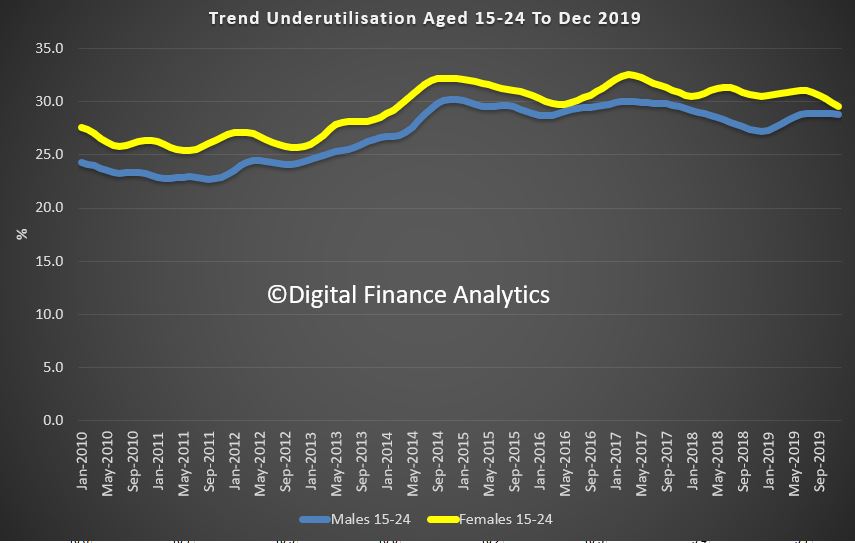
This may be enough to stay the RBA’s hand in February, as the headline rate fell, and the jobs hours worked rose, though there was a disproportionate shift towards part-time work, and the underutilisation rate is also higher. In fact, the fall can be best linked to a falling participation rate as more chose not to work over the summer. So nothing here to really support signs of a stronger economy. Underutilisation among the 15-25’s is above 25%.
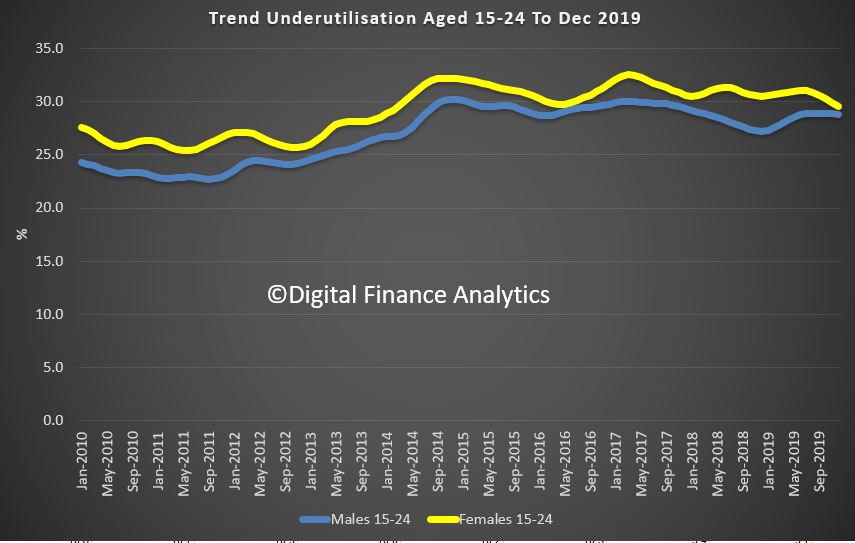
Employment and hours
In December 2019, trend monthly employment increased by around 18,000 people. Both full-time and part-time employment increased by around 9,000 people.
Over the past year, trend employment increased by around 261,000 people (2.1 per cent), which continued to be above the average annual growth over the past 20 years (2.0 per cent).
Full-time employment growth (1.5 per cent) was below the average annual growth over the past 20 years (1.6 per cent) and part-time employment growth (3.2 per cent) was above the average annual growth over the past 20 years (3.0 per cent).
“While there has been stronger growth in part-time employment over the past year, the underemployment rate is still where it was last December, at 8.3 per cent,” said Mr Hockman.
The trend monthly hours worked increased by 0.2 per cent in December 2019 and by 1.7 per cent over the past year. This was in line with the 20 year average annual growth of 1.7 per cent.
Underemployment and underutilisation
The trend monthly underemployment rate remained steady at 8.3 per cent in December 2019, unchanged over the past year. The trend monthly underutilisation rate also remained steady at 13.5 per cent in December 2019, an increase of 0.2 percentage points over the past year.

States and territories trend unemployment rate
The monthly trend unemployment rate increased in the Northern Territory, and decreased in Queensland and Tasmania in December 2019. The unemployment rate remained steady in all other states and the Australian Capital Territory.
Over the year, unemployment rates fell in Queensland, Western Australia, Tasmania and the Australian Capital Territory. Unemployment rates increased in all other states and the Northern Territory.
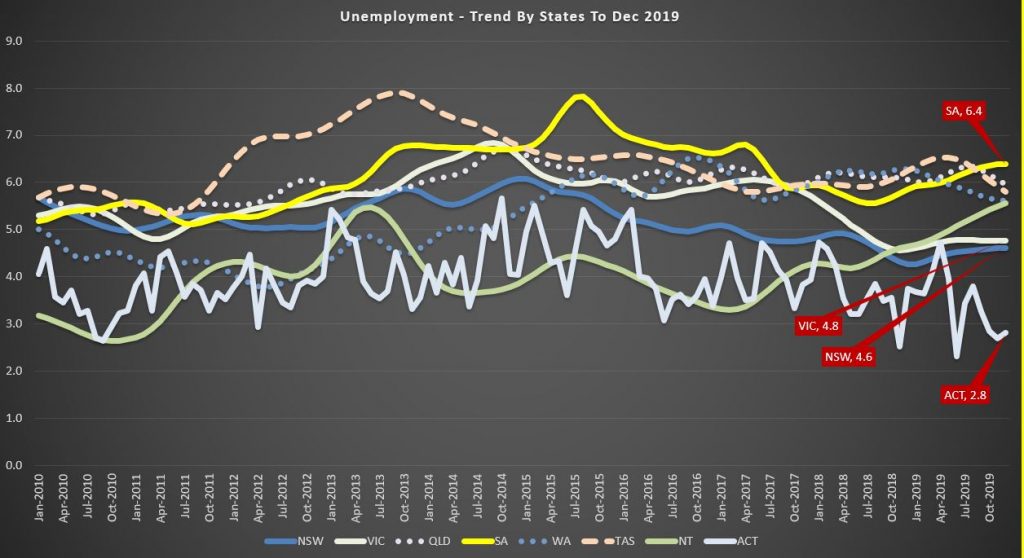
Seasonally adjusted data
The seasonally adjusted unemployment rate decreased by 0.1 percentage points to 5.1 per cent in December 2019, while the underemployment rate remained steady at 8.3 per cent. The seasonally adjusted participation rate remained steady at 66.0 per cent, and the number of people employed increased by around 29,000.
The net movement of employed in both trend and seasonally adjusted terms is underpinned by around 300,000 people entering and leaving employment in the month.
Australia’s trend unemployment rate decreased by less than 0.1 percentage points to 5.2 per cent in November 2019, according to the latest information released by the Australian Bureau of Statistics (ABS) today.
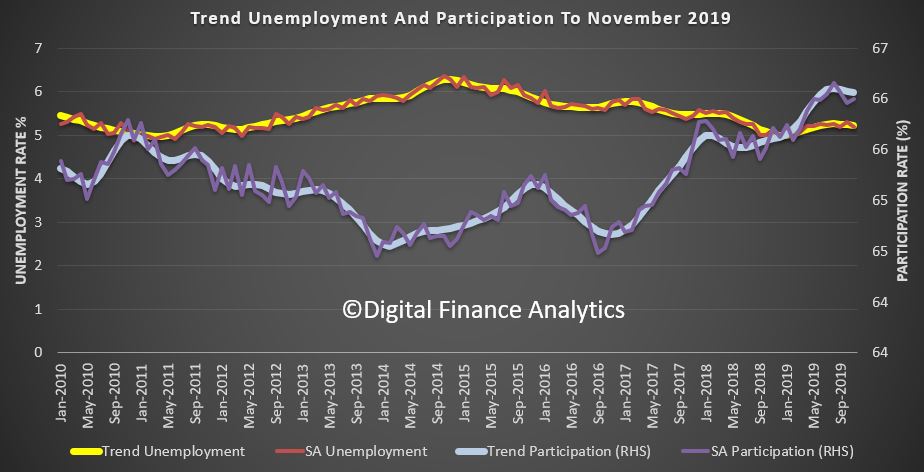
ABS Chief Economist Bruce Hockman said: “In November 2019, the trend unemployment rate decreased slightly to 5.2 per cent, the same level it was six months ago.”
“Over the past six months, the trend unemployment rate, participation rate and employment to population ratio have all remained relatively stable,” said Mr Hockman.
Employment and hours
In November 2019, trend monthly employment increased by around 17,000 people. Full-time employment increased by around 8,000 people and part-time employment increased by around 9,000 people.
Over the past year, trend employment increased by around 269,000 people (2.1 per cent), which continued to be above the average annual growth over the past 20 years (2.0 per cent). Full-time employment increased at the same rate as the past 20 years (1.6 per cent), and part-time employment (3.2 per cent) was above the average annual growth over the past 20 years (3.0 per cent).
The trend monthly hours worked increased by 0.1 per cent in November 2019 and by 1.6 per cent over the past year. This was slightly below the 20 year average annual growth of 1.7 per cent.
Underemployment and underutilisation
The trend monthly underemployment rate remained steady at 8.4 per cent in November 2019, an increase of 0.1 percentage points over the past year. The trend monthly underutilisation rate also remained steady at 13.6 per cent in November 2019, an increase of 0.3 percentage points over the past year.
States and territories trend unemployment rate
The monthly trend unemployment rate remained steady in Victoria, Queensland, South Australia and the Australian Capital Territory in November 2019. The unemployment rate increased in New South Wales, Western Australia and the Northern Territory, and decreased in Tasmania.
Over the year, unemployment rates fell in Western Australia and the Australian Capital Territory. The unemployment rate increased in all other states and the Northern Territory, except Tasmania where the rate was the same as it was 12 months ago.
Over the past year, trend employment increased by 268,900 people (or 2.1%), which was above the average annual growth rate over the past 20 years of 2.0%. Over the same 12 months, the trend employment to population ratio, which is a measure of how employed the population (aged 15 years and over) is, increased by 0.3 percentage points (pts) to 62.6%.
Dynamic Market changes
Trend employment increased by 17,400 people (0.13%) between October and November 2019. This was below the monthly average growth rate over the last 20 years of 0.16%.
Underpinning these net changes in employment is extensive dynamic change, which occurs each month in the labour market. In recent months there has been more than 300,000 people entering and leaving employment. There is also further dynamic change in the hours that people work, which results in changes in the full-time and part-time composition of employment.
Trend full-time employment increased by 8,300 people between October and November 2019, and part-time employment increased by 9,000 people. Compared to a year ago, there were 140,800 more people employed full-time and 128,100 more people employed part-time. This compositional change has led to an increase in the part-time share of employment from 31.4% to 31.8%.
The trend estimate of monthly hours worked in all jobs increased by 2.3 million hours (0.1%) to 1,782.8 million hours in November 2019. Over the past year, monthly hours worked in all jobs increased by 1.6%, below the 2.1% increase in employed people. In November, the average hours worked per employed person was around 137.5 hours per month or around 31.7 hours per week.
The trend unemployment rate decreased by less than 0.1 pts to 5.2% in November 2019. The number of unemployed people decreased by 1,200 in November 2019 to 716,300 people, and by 44,000 people since November 2018.
The trend participation rate remained steady at 66.1% in November 2019, and was 0.5 pts higher than in November 2018. The female participation rate remained steady at 61.2% and the male participation rate remained steady at 71.1%.
The labour force includes the total number of employed and unemployed people. Over the past 12 months, the labour force increased by 312,900 people (2.3%). This rate of increase was above the rate of increase for the total Civilian Population aged 15 years and over (1.6%).
The trend participation rate for 15-64 year olds, which controls (in part) for the effects of an aging population, remained steady at 78.7%. The gap between male and female participation rates in this age group was less than 10 pts, at 83.2% and 74.2% respectively, continuing the long term convergence of male and female participation.
The trend participation rate for 15-24 year olds (who are often referred to as the “youth” group in the labour market) remained steady at 68.1%. The unemployment rate for this group remained steady at 11.7% from October to November 2019, and has increased by 0.3 pts since November 2018.
Seasonally adjusted data
The seasonally adjusted unemployment rate decreased by 0.1 percentage points to 5.2 per cent in November 2019, while the underemployment rate decreased by 0.2 percentage points to 8.3 per cent. The seasonally adjusted participation rate remained steady at 66.0 per cent, and the number of people employed increased by around 40,000.
The net movement of employed in both trend and seasonally adjusted terms is underpinned by around 300,000 people entering and leaving employment in the month
Rotational Data
In original terms, the incoming rotation group in November 2019 had a lower employment to population ratio than the group it replaced (62.5% in November 2019, compared to 63.2% in October 2019), and was lower than the sample as a whole (62.8%). The incoming rotation group had a lower full-time employment to population ratio than the group it replaced (42.5% in November 2019, compared to 43.8% in October 2019), and was lower than the sample as a whole (42.9%).
The unemployment rate of the incoming rotation group was higher than the group it replaced (5.2% in November 2019, compared to 4.8% in October 2019) and was higher than the sample as a whole (4.8%). The participation rate of the incoming rotation group was lower than the group it replaced (66.0% in November 2019, compared to 66.4% in October 2019) and higher than the sample as a whole (65.9%).
In looking ahead to the December 2019 estimates, in original terms, the outgoing rotation group in November 2019, that will be replaced by a new incoming rotation group in December 2019, had a lower employment to population ratio in November 2019 (62.3%) compared to the sample as a whole (62.8%). The outgoing rotation group in November 2019 had a lower full-time employment to population ratio (42.7%) than the sample as a whole (42.9%).
The outgoing rotation group had a higher unemployment rate in November 2019 (4.9%) compared to the sample as a whole (4.8%). The participation rate of the outgoing rotation group in November 2019 (65.5%) was lower than the sample as a whole (65.9%).
We review the latest data from the ABS, and the 19,000 FALL in jobs, the first for some time.
https://www.abs.gov.au/AUSSTATS/abs@.nsf/DetailsPage/6202.0Oct%202019?OpenDocument
Australia’s trend unemployment rate remained steady at 5.3 per cent in October 2019, according to the latest information released by the Australian Bureau of Statistics (ABS) today. The unemployment rate increased in the Northern Territory and New South Wales, and decreased in Tasmania.
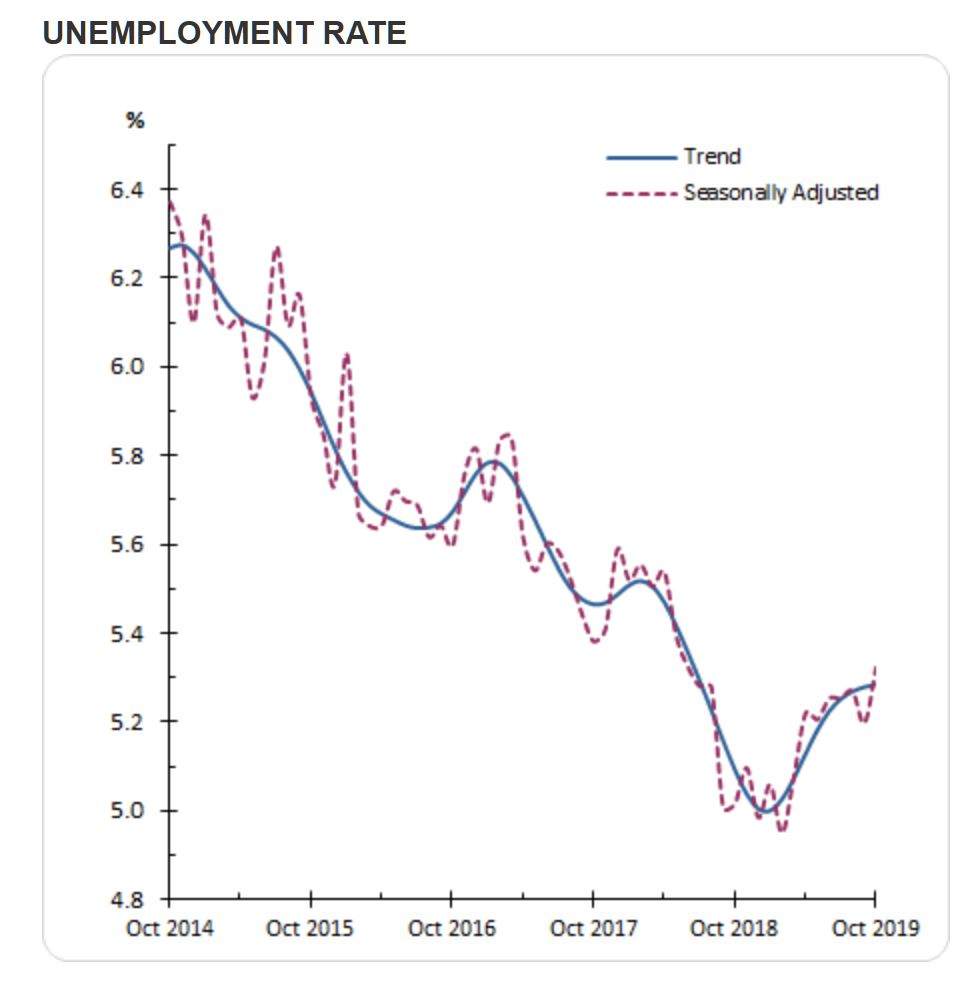
Trend unemployment in October 2019 remained steady at 5.3 per cent, 0.2 percentage points higher than the same time last year.
The increase in the unemployment rate over the past year has coincided with a 0.5 percentage point increase in the participation rate, from 65.6 per cent to 66.1 per cent.
The trend monthly underutilisation rate also remained steady at 13.8 per cent in October 2019, an increase of 0.4 percentage points over the past year.
Employment and hours
In October 2019, trend monthly employment increased by around 12,300 people. Full-time employment increased by around 5,800 people and part-time employment increased by around 6,500 people.
Over the past year, trend employment increased by around 268,500 people (2.1 per cent), which continued to be above the average annual growth over the past 20 years (2.0 per cent). Full-time employment increased by 1.8 per cent and part-time employment increased by 2.8 per cent over the past year.
The trend monthly hours worked increased by 0.2 per cent in October 2019 and by 1.7 per cent over the past year. This was slightly above the 20 year average year-on-year growth of 1.6 per cent.
Underemployment and underutilisation
The trend monthly underemployment rate remained steady at 8.5 per cent in October 2019, an increase of 0.2 percentage points over the past year. The trend monthly underutilisation rate also remained steady at 13.8 per cent in October 2019, an increase of 0.4 percentage points over the past year.
States and territories trend unemployment rate
The monthly trend unemployment rate remained steady in Victoria, Queensland, South Australia, Western Australia and the Australian Capital Territory in October 2019. The unemployment rate increased in the Northern Territory and New South Wales, and decreased in Tasmania.
Over the year, unemployment rates fell in Western Australia and the Australian Capital Territory, and increased in all other states and territory.
Seasonally adjusted data
The seasonally adjusted unemployment rate increased by 0.1 percentage points to 5.3 per cent in October 2019, while the underemployment rate increased by 0.2 percentage points to 8.5 per cent. The seasonally adjusted participation rate decreased by 0.1 percentage points to 66.0 per cent, and the number of people employed decreased by around 19,000.
The net movement of employed in both trend and seasonally adjusted terms is underpinned by around 300,000 people entering and leaving employment each month.
Note that in original terms, the incoming rotation group in October 2019 had a higher employment to population ratio than the group it replaced (63.0% in October 2019, compared to 61.7% in September 2019), and was higher than the sample as a whole (62.4%). The incoming rotation group had a higher full-time employment to population ratio than the group it replaced (42.8% in October 2019, compared to 41.9% in September 2019), and was higher than the sample as a whole (42.5%).
The unemployment rate of the incoming rotation group was lower than the group it replaced (5.3% in October 2019, compared to 5.4% in September 2019) and was higher than the sample as a whole (5.1%). The participation rate of the incoming rotation group was higher than the group it replaced (66.4% in October 2019, compared to 65.2% in September 2019) and higher than the sample as a whole (65.7%).
Australia’s trend unemployment rate remained steady at 5.3 per cent in September 2019, according to the latest information released by the Australian Bureau of Statistics (ABS).
“All of Australia’s key trend measures remained steady in September 2019, with the unemployment rate at 5.3 per cent and the participation rate at 66.2 per cent.” said ABS Chief Economist Bruce Hockman.
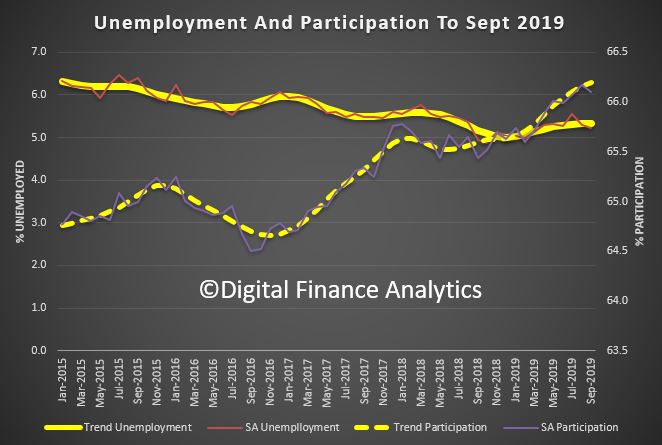
Employment and hours
In September 2019, trend monthly employment increased by around 20,200 people. Full-time employment increased by about 9,000 people and part-time employment increased by about 11,300 people.
Over the past year, trend employment increased by about 300,000 people (2.4 per cent), which continued to be above the average annual growth over the past 20 years (2.0 per cent). Full-time employment increased by 2.1 per cent and part-time employment increased by 2.9 per cent over the past year.
The trend monthly hours worked increased by 0.1 per cent in September 2019 and by 1.8 per cent over the past year. This was slightly above the 20 year average year-on-year growth of 1.7 per cent.
Annual Employment Change Over 20 Years (%)
Underemployment and underutilisation
The trend monthly underemployment rate remained steady at 8.4 per cent in September 2019, an increase of 0.1 percentage points over the past year. The trend monthly underutilisation rate remained steady at 13.7 per cent, an increase of 0.2 percentage points over the past year.
States and territories trend unemployment rate
The monthly trend unemployment rate remained steady in half of the states and territories in September 2019. Unemployment rate changes occurred in the Northern Territory (up 0.2 percentage points), Queensland and South Australia (up 0.1 percentage points) and Western Australia (down 0.1 percentage points).
Over the year, unemployment rates fell in Western Australia and the Australian Capital Territory, and increased in Victoria, Queensland, South Australia, Tasmania and the Northern Territory.
Seasonally adjusted data
The seasonally adjusted unemployment rate decreased by less than 0.1 percentage points to 5.2 per cent in September 2019, while the underemployment rate decreased by 0.2 percentage points to 8.3 per cent. The seasonally adjusted participation rate decreased by less than 0.1 percentage points to 66.1 per cent, and the number of people employed increased by an estimated 14,700.
The net movement of employed in both trend and seasonally adjusted terms is underpinned by around 300,000 people entering and leaving employment in the month.
Australia’s trend unemployment rate increased in July 2019 to 5.3 per cent, from 5.2 per cent in June, according to the latest information released by the Australian Bureau of Statistics (ABS).
ABS Chief Economist Bruce Hockman said: “Australia’s trend unemployment rate increased to 5.3 per cent in July 2019, the same level as this time last year.”
“The trend participation rate increased further to 66.1 per cent, while employment growth continues to show strength,” added Mr Hockman.
Employment and hours
In July 2019, trend monthly employment increased by around 24,600 persons. Full-time employment increased by 15,100 persons and part-time employment increased by 9,600 persons.
Over the past year, trend employment increased by 339,200 persons (2.7 per cent) which was above the average annual growth over the past 20 years (2.0 per cent).
The trend monthly hours worked increased by less than 0.1 per cent in
July 2019 and by 1.8 per cent over the past year. This was slightly
above the 20 year average year-on-year growth of 1.7 per cent.
Underemployment and underutilisation
The trend monthly underemployment rate remained steady at 8.4 per cent
in July with no changes over the past year. The trend underutilisation
rate decreased by 0.1 percentage points over the year.
States and territories trend unemployment rate
The trend unemployment rate remained steady in most states and
territories, except for South Australia (up 0.2 percentage points) and
Queensland and Northern Territory (up 0.1 percentage points).
Over the year, unemployment rates fell in New South Wales, Victoria,
Western Australia and the Australian Capital Territory, and increased in
Queensland, South Australia, Tasmania and the Northern Territory.
We look at the latest from the ABS.

We look at the latest data from the ABS. Its a mixed bag!